No CrossRef data available.
Article contents
José A. Sánchez Fajardo, Pejorative suffixes and combining forms in English (Studies in Language Companion Series 222). Amsterdam and Philadelphia: John Benjamins, 2022. Pp. xvi + 229. ISBN 9789027210609.
Review products
José A. Sánchez Fajardo, Pejorative suffixes and combining forms in English (Studies in Language Companion Series 222). Amsterdam and Philadelphia: John Benjamins, 2022. Pp. xvi + 229. ISBN 9789027210609.
Published online by Cambridge University Press: 15 February 2023
Abstract
An abstract is not available for this content so a preview has been provided. Please use the Get access link above for information on how to access this content.

- Type
- Book Review
- Information
- Copyright
- Copyright © The Author(s), 2023. Published by Cambridge University Press
References
Allen, Harold B. 1958. Pejorative terms for Midwest farmers. American Speech 33, 260–5.CrossRefGoogle Scholar
Bauer, Laurie. 1983. English word formation. Cambridge: Cambridge University Press.CrossRefGoogle Scholar
Bauer, Laurie. 1998. Is there a class of neoclassical compounds, and if so is it productive? Linguistics 36(3), 403–22.CrossRefGoogle Scholar
Berman, J. M. 1961. Contribution on blending. Zeitschrift für Anglistik und Amerikanistik 9, 278–81.Google Scholar
Dressler, Wolfgang U. & Barbaresi, Lavinia Merlini. 2001. Morphopragmatics of diminutives and augmentatives: On the priority of pragmatics over semantics. In Kenesei, István & Harnish, Robert M. (eds.), Perspectives on semantics, pragmatics and discourse: A festschrift for Ferenc Kiefer, 43–58. Amsterdam and Philadelphia: John Benjamins.CrossRefGoogle Scholar
Dressler, Wolfgang U. & Barbaresi, Lavinia Merlini. 2013. Pragmatics and morphology: Morphopragmatics. In Huang, Yan (ed.), The Oxford handbook of pragmatics. Oxford: Oxford University Press. https://doi.org/10.1093/oxfordhb/9780199697960.013.20 (accessed 27 November 2022).Google Scholar
Eitelmann, Matthias, Haugland, Kari E. & Haumann, Dagmar. 2020. From engl-isc to whatever-ish: A corpus-based investigation of -ish derivation in the history of English. English Language and Linguistics 24(4), 801–31.CrossRefGoogle Scholar
Finkbeiner, Rita, Meibauer, Jörg & Wiese, Heiker. 2016. Pejoration. Amsterdam and Philadelphia: John Benjamins.CrossRefGoogle Scholar
Hamans, Camiel. 2010. The productivity of blending: Linguistic or cognitive? Or how to deal with ‘administrivia’ and ‘ostalgia’. In Stanulewicz, Danuta, Wolański, Tadeusz Z. & Redzmiska, Joanna (eds.), Lingua terra cognita, vol. 2: A festschrift for Professor Roman Kalisz, 467–90. Gdańsk: Wydawnictwo Uniwersytetu Gdańskiego.Google Scholar
Kastovsky, Dieter. 2009. Astronaut, astrology, astrophysics: About combining forms, classical compounds and affixoids. In McConchie, R. W., Honkapohja, Alpo & Tyrkkö, Jukka (eds.), Selected proceedings of the 2008 symposium on New Approaches in Historical Lexis (HEL-LEX 2), 1–13. Somerville, MA: Cascadilla Proceedings Projects.Google Scholar
Lehrer, Adrienne. 2007. Blendalicious. In Munat, Judith (ed.), Lexical creativity, texts and contexts, 115–33. Amsterdam and Philadelphia: John Benjamins.CrossRefGoogle Scholar
López Rúa, Paula. 2004. The categorical continuum of English blends. English Studies 85(1), 63–76.Google Scholar
Mattiello, Elisa. 2013. Extra-grammatical morphology in English: Abbreviations, blends, reduplicatives, and related phenomena. Berlin: Mouton de Gruyter.CrossRefGoogle Scholar
McMillan, James B. 1978. American lexicology 1942–1973. American Speech 53(2), 141–63.CrossRefGoogle Scholar
Merlini Barbaresi, Lavinia & Dressler, Wolfgang U.. 2020. Pragmatics explanations in morphology. In Pirrelli, Vito, Plag, Inglo & Dressler, Wolfgang U. (eds.), Word knowledge and word usage, 405–52. Berlin: De Gruyter Mouton.CrossRefGoogle Scholar
Pederson, Lee A. 1964. Terms of abuse for some Chicago social groups. Publication of the American Dialect Society 42, 26–48.CrossRefGoogle Scholar
Plag, Ingo. 2018 [2003]. Word-formation in English. Cambridge: Cambridge University Press.CrossRefGoogle Scholar
Sánchez Fajardo, José A. 2021. Morphophonological salience through constructional schemas: An analysis of two case studies of English slang words ending in {o}. Brno Studies in English 47(1), 47–71.CrossRefGoogle Scholar
Sánchez Fajardo, José A. & Tarasova, Elizaveta. 2020. Of brownie girls and Aussie families: A new look at morphosemantic paradigmaticity in Adj+ie/y nominalisations. In Fernández-Domínguez, Jesús, Bagasheva, Alexandra & Lara-Clares, Cristina (eds.), Paradigmatic relations in word formation, 186–212. Amsterdam: Brill.CrossRefGoogle Scholar
Schreuder, Hindrik. 1970. Pejorative sense development in English. College Park, MD: McGrath.Google Scholar





